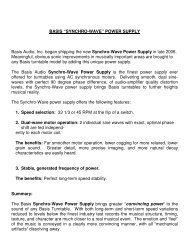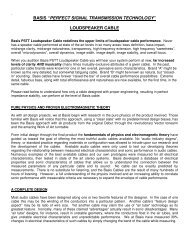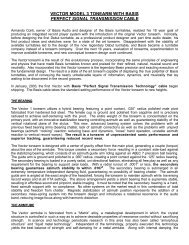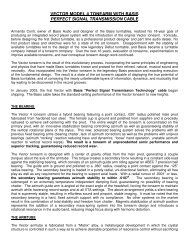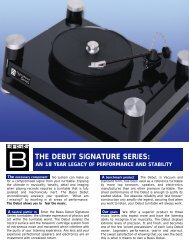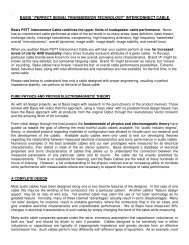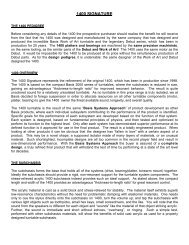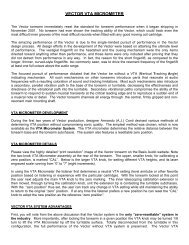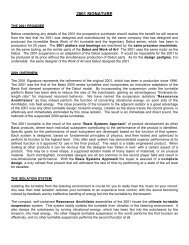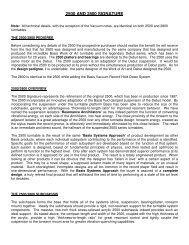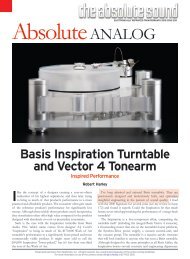VECTOR EFFECTIVE MASS FINE TUNING WEIGHTS - Basis Audio
VECTOR EFFECTIVE MASS FINE TUNING WEIGHTS - Basis Audio
VECTOR EFFECTIVE MASS FINE TUNING WEIGHTS - Basis Audio
You also want an ePaper? Increase the reach of your titles
YUMPU automatically turns print PDFs into web optimized ePapers that Google loves.
<strong>VECTOR</strong> <strong>EFFECTIVE</strong> <strong>MASS</strong> <strong>FINE</strong> <strong>TUNING</strong> <strong>WEIGHTS</strong>THE PHYSICS OF <strong>EFFECTIVE</strong> <strong>MASS</strong>There are many dogmatic “rules” regarding the placement of tonearm counterweights, such as “thecounterweight should always be as close as possible to the pivot”. Some of these rules were born whentonearm “designers” published articles, white papers, or were interviewed as “experts” by audio magazines.Unfortunately, like most dogma as it relates to complex mechanical systems whose behavior is attempted to beanalyzed by “seat of the pants experts”, the “rules” are almost always wrong, or are only “situationally” correct.Because an experiment worked in one system, the wrong conclusion that the theory was correct across a widerange of systems was assumed. This is one of many examples in the record player industry of the designerhaving a fundamental misunderstanding of the basic laws of physics and the studies of Statics, Dynamics,Strength of Materials, and Vibrational System Theory, all of which are derived from the laws and principlesof physics. (Strength of Materials is not to be confused with a discussion on the strength and properties ofvarious materials. Rather, it is the study of stresses, strains, and all behavior of mechanical members ofdifferent shapes.) The Vector tonearm is certainly the only commercially available tonearm which is basedupon a scientifically reasonable and plausible “engineering model” and the correct analysis of that model toyield a pick-up system of truly linear response. Based on the engineering model and subsequent analysis, it istherefore not entirely surprising that the Vector is the first tonearm to be free of mistracking during the play ofmusical signal, and is the first essentially silent tonearm when the cartridge is tracing the record grooves.(However, when being compared to other tonearms, yes, this behavior is totally surprising.)One small subset of the analysis of a tonearm system is the counterweight system. Counterweights areprobably the most popular subject of “elevator theorizing” on tonearm design. Commonly heard dogmatic butunfounded rules include “It should always be close.” “It should hang low.” “It should always be decoupled.”Without qualifying each of these statements with the particulars of the exact problem posed by the cartridgeand tonearm characteristics the generalized statements can be shown to be false. This is typical of therampant “phony physics” and “pseudo science” put forth by many experimenters (calling themselves “productdesigners”) in high-end audio. This subject is of such complexity that a multi-page engineering paper suitablefor a term project discussing the physics of tonearm counterweight systems could be written. That discussion,although modeled, tested and documented by <strong>Basis</strong>, is beyond the scope of this text.The one basic tenet that the reader should grasp is that the counterbalance effect, or torque of thecounterweight, for a given desired amount, can be achieved by an infinite number of combinations ofcounterweight masess and distances from the pivot. Although the torque of each combination would be thesame (resulting in the same tracking force), the moment of inertia (contribution to the effective mass of thetonearm) is different. The rule of thumb to remember is:Any single counterweight that is lighter, and pushed further out on the shaft results in a highercontribution to the moment of inertia of the arm. Any counterweight that is heavier and pushed furtherin on the shaft will result in a lower contribution to the moment of inertia of the arm.The fine tuning weights, when used closer to the pivot than the main counterweight, will lower theeffective mass of the arm. When used beyond the main counterweight they will have a smaller effect,and will sometimes raise, but other times lower, the effective mass of the tonearm.The reason dogmatic statements can not be made about which situation is better is that sometimes, withcertain cartridges, lower effective mass is beneficial. In other cases the opposite is true. A specification on thecompliance of the cartridge is not a reliable indicator of which configuration would be better, as the complianceof a cartridge is not linear, and is itself the result of multiple miniature “mass-spring systems”. The analysis ofthis incredibly complex system would be non-linear and involve complex high-order differential equations. Thebest indicator of the optimal counterweight configuration is sound. The erroneous conclusion that states thatthe ideal situation is the heavier counterweight closer to the pivot was certainly spread by individuals not
understanding the most basic science behind tonearms. Most likely they were seeing better results that weredue to the tonearms being too heavy for the prevalent cartridges of the era (no longer the case), or thatsuffered from inadequate counterweight shaft stiffness or damping. You should resist forming any conclusionbefore your testing so that you can objectively determine the configuration that sounds best to you.USE OF THE <strong>TUNING</strong> <strong>WEIGHTS</strong>In using the 2 Vector tuning weights, it would first be advisable to become accustomed to the sound of thesystem with only 1 main counterweight. Then, at some point, one could install a fine tuning weight in front of(closer to the pivot) the main counterweight. Reset the tracking force, and listen to your favorite records. Thisconfiguration will result in a slightly lower effective mass. Listen particularly to the lower frequencies for detail,dynamics, and depth to determine which effective mass you prefer.One can also use 2 of the weights together, and the fine tuning weights can be placed behind (toward the endof the shaft) the main counterweight. It must be pointed out that the effect of using the fine tuning weights inthis position will be more unpredictable than using them in front of the main weight. As stated earlier, in front ofthe main weight they will cause the effective mass of the arm to be lower. When placed behind the mainweight the fine tuning weights will sometimes raise but other times lower the effective mass of the arm. Thiswill depend upon the original position of the main weight and the position chosen for the fine tuning weight(s).Placing the fine tuning weights in front of the main weight, closer the pivot, will make a larger overall change inthe effective mass than placing the tuning weights behind the main counterweight. (The opinion of somereaders may be that placing the counterweights behind the main weight cannot have 2 different effects on theeffective mass depending on the situation. For those readers we can furnish more detail and the mathematicalanalysis which proves the <strong>Basis</strong> stance.)Determining the optimum position of the weights will be a matter of trial and error, comparable to setting VTA.The results may not make any sense to you, and the system is complex enough that the sonic results probablyshould not make sense! Should you find the process too frustrating simply go back to the single maincounterweight and enjoy the music. Without any fine-tuning of counterweights the Vector represents a stepforward in tonearm performance. Lengthy discussions over the telephone or e-mail are not something in whichwe at <strong>Basis</strong> <strong>Audio</strong> can engage as the results are too unpredictable and system dependent. We spent severalthousand dollars to make the weights available as our experience has shown us that certain individuals willspend hours tuning and adjusting to achieve the best sound, and will welcome the opportunity to fine tune theirrecord player system.We at <strong>Basis</strong> would like the reader to contemplate the hours spent on the above research and the effort inmaking the parts available. These parts obviously can never be justified as a commercial product. Instead,the research and the weights themselves are done as a purely academic exercise to better understandtonearm behavior and then to offer to the audiophile a chance to experiment himself and possibly improve hissystem. Projects such as this make <strong>Basis</strong> stand alone in the understanding of all of the factors affecting recordplayback. <strong>Basis</strong> therefore also stands alone in offering superior analog products based on science as well asthe art of listening.



